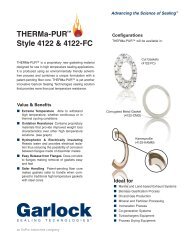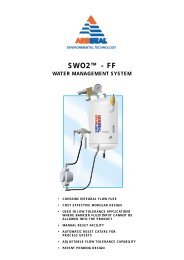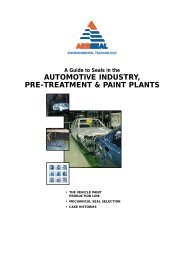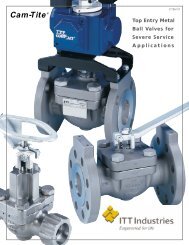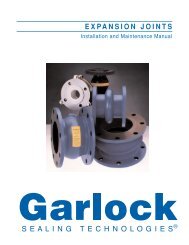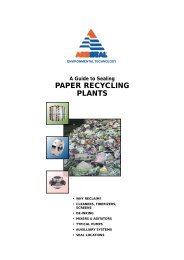Engineered Gasketing Products - RevBase
Engineered Gasketing Products - RevBase
Engineered Gasketing Products - RevBase
You also want an ePaper? Increase the reach of your titles
YUMPU automatically turns print PDFs into web optimized ePapers that Google loves.
Monomers<br />
Monomers are materials, such as styrene and vinyl chloride,<br />
which can combine with themselves and become polymers,<br />
such as polystyrene and polyvinyl chloride. GYLON ® Styles<br />
3510 and 3530 are recommended for monomers, since elastomer-bound<br />
gaskets are rarely compatible with monomers.<br />
Some monomers, under certain conditions, will penetrate a<br />
gasket and polymerize inside the gasket, causing the gasket<br />
to swell and, occasionally, rupture. This effect is known as<br />
"popcorning". This effect can be reduced or eliminated with<br />
additional compressive load which lowers the void space<br />
inherent in a gasket.<br />
NSP 61 for Drinking Water<br />
See Stress Saver XP, catalog page 16.<br />
Oxidizers<br />
Certain chemicals are known as strong oxidizers and, as<br />
such, will readily combine with organic compounds. We<br />
recommend our GYLON ® material for use in oxidizers.<br />
Oxygen Service<br />
We recommend GYLON ® Styles 3502, 3505, 3503 and metalinserted<br />
Styles 3562 and 3563. These gaskets are specially<br />
manufactured and packaged to eliminate contamination by<br />
organic material. GRAPH-LOCK ® Styles 3123 (1/16" thick<br />
max) and 3128 HOCH-DRUCK ® are also acceptable.<br />
pH<br />
The pH scale is a measure of the acidity or alkalinity of a<br />
solution. A pH of 7 is a neutral reading; it is neither acidic<br />
or alkaline. Readings of 1-2 are strongly acidic, while 13-14<br />
indicates a strong alkaline or caustic media.<br />
Note: A pH reading alone without the names of the chemicals<br />
involved is not enough to select a gasket. Also, since the pH<br />
scale is quite limited in range, a reading of "1" or "14" does not<br />
fully describe the concentration. We need the concentration<br />
expressed as a percentage. For example, sodium hydroxide<br />
at a con-centration of around 4% will "peg" the pH scale at<br />
14, the same reading produced by a 40% concentration.<br />
Pressure Spikes<br />
Very high pressure spikes can occur in any line pumping a<br />
liquid if a valve is closed rapidly, leaving the fluid flow nowhere<br />
to go. The inertia of the fluid may create extreme pressure<br />
spikes. These spikes occur too rapidly to be detected by a<br />
pressure gage but can cause a gasket to blow out.<br />
Questions? Call Gasket Applications Engineering<br />
at 1-800-448-6688<br />
Radiation Resistance<br />
We have conducted gamma radiation tests on our compressed<br />
sheet Styles 3000, 3200, 3400, 3700, 5500, 5507,<br />
9800, 9850, 9920 and ST-706. These tests indicate our<br />
compressed non-asbestos styles will handle a total exposure<br />
of approximately 5 x 10 7 rads of gamma radiation. GYLON ®<br />
Styles 3510 and 3545 have been tested. Test results are<br />
available.<br />
Refrigerants<br />
A number of new refrigerants have been introduced in an effort<br />
to protect the environment. CFC-type refrigerants, believed to<br />
be responsible for depleting the ozone layer, are being phased<br />
out and replaced by HCFCs and HFCs. Our most frequent<br />
compatibility inquiries concentrate on R-134a, R-123 and<br />
R-141b. Information provided by refrigerant manufacturers<br />
indicates Style 3300 will be preferred for R-134a and R-123.<br />
Styles 5500, 3000 and 3300 are recommended for R-141b.<br />
Refer to the Chemical Resistance chart for a complete listing<br />
of refrigerants. The compatibility of the lubricants used with<br />
these refrigerants should be considered.<br />
Reuse of Gaskets<br />
We are frequently asked about reusing a gasket. We do not<br />
recommend this practice. A gasket’s function is to conform to<br />
flange high and low spots when compressed, and its ability<br />
to reseal decreases after it is compressed. Gaskets which<br />
contain rubber and which have experienced elevated temperatures<br />
will be even less likely to reseal.<br />
Shelf Life<br />
Garlock has spec sheets detailing proper storage conditions<br />
and expected shelf life for our products. Available upon<br />
request.<br />
Spacers in Flanges<br />
Some installations require a very thick gasket to fill a large<br />
gap between flanges. We do not recommend stacking numerous<br />
gaskets in the same flange. In-house tests have shown<br />
that a better way to fill a 1/2" gap, for example, is to install<br />
a 1/16" gasket on each side of a 3/8" thick incompressible<br />
spacer ring. Ideally, the spacer ring will be consistent with<br />
piping metallurgy, serrated, and cut to the same dimensions<br />
as the gasket. We recommend higher minimum torques when<br />
using this arrangement.<br />
C-49



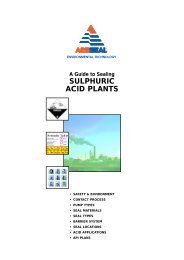
![VCS Flange Gasket [1.03 MB] - AR Thomson Group](https://img.yumpu.com/12044617/1/190x245/vcs-flange-gasket-103-mb-ar-thomson-group.jpg?quality=85)

![PGE Flange Gasket Product Brochure [1.04 MB] - AR Thomson Group](https://img.yumpu.com/12044595/1/190x245/pge-flange-gasket-product-brochure-104-mb-ar-thomson-group.jpg?quality=85)
